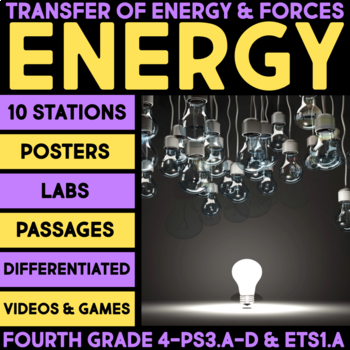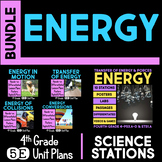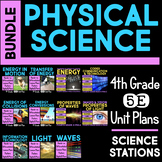Energy, Forms of Energy, Transformations, Potential and Kinetic Transfer, Sound
- Zip

What educators are saying
Products in this Bundle (10)
showing 1-5 of 10 products
Bonus
Also included in
- Physical Science Stations for Fourth Grade is a BUNDLE of the following stations:See each individual set of stations for a preview:✔ Energy, Energy, Everywhere Science Stations (10 stations)✔ Making Waves - Wave Properties Science Stations (8 stations)✔ Images and Vision (8 stations)✔ Exploring CommPrice $57.00Original Price $103.24Save $46.24
- A BUNDLE of 88 Fourth Grade Science Stations that cover all Next Generation Science Standards for fourth grade. This year long BUNDLE is full of hands-on, engaging science activities and experiments that last the entire school year.ELEVEN Science Topics that cover all the NGSS for fourth gradeEIGHTPrice $159.00Original Price $305.35Save $146.35
- This is a BUNDLE of all the 5E Unit Plans AND Science Stations for Fourth Grade. There are 88 Fourth Grade Science Stations in 11 Units and 14 5E Model Instructional Units.This MEGA BUNDLE includes the following 5e Model units:Physical ScienceEnergy in MotionTransfer of EnergyEnergy of CollisionsEnePrice $252.00Original Price $434.40Save $182.40
- This is a BUNDLE of all of the 5E ENERGY Units for fourth grade AND the Science Stations for Energy. Topics include: Energy in Motion, Transfer of Energy, Energy of Collisions, and Energy Conversions. 5E ENERGY IN MOTION5E TRANSFER OF ENERGY5E ENERGY OF COLLISIONS5E ENERGY CONVERSIONSEnergy SciencePrice $42.00Original Price $69.25Save $27.25
- This is a BUNDLE of all of the Physical Science 5E Units for fourth grade AND the Science Station Units for Physical Science. Units in this Physical Science BUNDLE include5E Energy in Motion5E Transfer of Energy5E Energy of Collisions5E Energy Conversions5E Information Technology5E Light5E WavesSciePrice $89.00Original Price $177.45Save $88.45
Description
This 4th Grade NGSS Energy bundle includes 10 different science stations that teach concepts such as kinetic and potential energy, forms of energy, roller coasters, thermal energy, heat transfer, sound energy, the Law of Conservation of Energy, electrical energy, and light energy. Includes reading passages, investigations, experiments, and much more!
By working through this mega-set of stations, students will gain a robust understanding of energy, energy transfer, and conservation of energy. The Engineering Standards for fourth grade are also incorporated into this set of stations.
Energy Science Activities Include
► Vocabulary Cards in two formats with and without pictures.
► Watch a Video About Potential and Kinetic Energy - Students watch a video about energy or a video about kinetic and potential energy then answer questions about the video.
► Play a Game About Types of Energy and Energy Conversion - Students interact with a video game about different forms of energy of light energy then answer questions about the games.
► Investigate Potential and Kinetic Energy With a Marble Maze - Students build a rollercoaster to conduct an investigation about potential and kinetic energy. They discuss design challenges, constraints, and criteria. Students then answer questions to reinforce the concepts learned.
► Diagram Thermal Energy and Heat Energy Transfer - Students read about thermal energy and complete a diagram showing different ways heat is transferred. Students answer questions about the diagram.
► Read about Sound Energy - Students read a passage about sound energy and answer questions.
► Model - There are two modeling stations. #1: Model Electrical Energy in Batteries: Students read about and model the Law of Conservation of Energy then answer questions about it. #2: Model the Law of Conservation of Energy: Students read about electrical energy in batteries and make their own battery then answer questions about the model.
► Explore - There are two explore stations: #1: Explore Electrical Energy and Light With Circuits: Students read about and explore electrical energy then answer questions. #2: Explore Laser Light Reflection in Mirrors: Students read about different light energy and explore a laser light then answer questions.
► Sort Forms of Energy - Students read about different types of energy and sort pictures into categories matching the types of energy.
Google Classroom™️ Components Include
► Google Forms™️ with Reading Passages, Differentiated Questions and Links to the Videos and Games (all stations)
► Google Slides™️ with Activity Directions & Worksheets to record results (Investigate, Diagram, Model, Explore, and Sort)
While we have included Google Slides, many of the stations are hands-on.
Differentiated Comprehension Questions
Each station includes four different ways to respond to the experience at the station: short answer questions, fill-in the blank questions, task cards with short answers, task cards with multiple choice. All the variations are similar to one another. Choose the format that best fits your classroom and students. Students are encouraged to use their science journal, but worksheets are included as well.
Some stations include two or more activity choices and extension activities.
Each station is designed to last about 15-20 minutes. Students may do one a day for 8 days, 2 a day for four days, or any format that works for your classroom. Because there are additional activities for the Watch and Play stations, you can offer those as a choice within that station or offer them as an early finisher station, as well.
See the preview for additional information and details.
Additional Science Stations are also available.
CLICK HERE TO FOLLOW ME ON TPT
TERMS OF USE
Copyright © What I Have Learned, Jessica Boschen
Permission to copy for single classroom or homeschool family use only.
This product may not be distributed or displayed digitally for public view.
Please purchase additional licenses if you intend to share this product.










